3.9: Solve Equations Using Integers; The Division Property of Equality (Part 1)
( \newcommand{\kernel}{\mathrm{null}\,}\)
- Determine whether an integer is a solution of an equation
- Solve equations with integers using the Addition and Subtraction Properties of Equality
- Model the Division Property of Equality
- Solve equations using the Division Property of Equality
- Translate to an equation and solve
Before you get started, take this readiness quiz.
- Evaluate x+4 when x=−4. If you missed this problem, review Example 3.2.9.
- Solve: y−6=10. If you missed this problem, review Example 2.3.6.
- Translate into an algebraic expression 5 less than x. If you missed this problem, review Table 1.3.1.
Determine Whether a Number is a Solution of an Equation
In Solve Equations with the Subtraction and Addition Properties of Equality, we saw that a solution of an equation is a value of a variable that makes a true statement when substituted into that equation. In that section, we found solutions that were whole numbers. Now that we’ve worked with integers, we’ll find integer solutions to equations.
The steps we take to determine whether a number is a solution to an equation are the same whether the solution is a whole number or an integer.
Step 1. Substitute the number for the variable in the equation.
Step 2. Simplify the expressions on both sides of the equation.
Step 3. Determine whether the resulting equation is true.
- If it is true, the number is a solution.
- If it is not true, the number is not a solution.
Determine whether each of the following is a solution of 2x−5=−13:
- x=4
- x=−4
- x=−9
Solution
| (a) Substitute 4 for x in the equation to determine if it is true. | 2x − 5 = −13 |
| Substitute 4 for x. | 2(4)−5?=−13 |
| Multiply. | 8−5?=−13 |
| Subtract. | 3≠−13 |
Since x=4 does not result in a true equation, 4 is not a solution to the equation.
| (b) Substitute -4 for x in the equation to determine if it is true. | 2x − 5 = −13 |
| Substitute −4 for x. | 2(−4)−5?=−13 |
| Multiply. | −8−5?=−13 |
| Subtract. | −13=−13✓ |
Since x=−4 results in a true equation, −4 is a solution to the equation.
| (b) Substitute -9 for x in the equation to determine if it is true. | 2x − 5 = −13 |
| Substitute −9 for x. | 2(−9)−5?=−13 |
| Multiply. | −18−5?=−13 |
| Subtract. | −23≠−13 |
Since x=−9 does not result in a true equation, −9 is not a solution to the equation.
Determine whether each of the following is a solution of 2x−8=−14:
- x=−11
- x=11
- x=−3
- Answer a
-
no
- Answer b
-
no
- Answer c
-
yes
Determine whether each of the following is a solution of 2y+3=−11:
- y=4
- y=−4
- y=−7
- Answer a
-
no
- Answer b
-
no
- Answer c
-
yes
Solve Equations with Integers Using the Addition and Subtraction Properties of Equality
In Solve Equations with the Subtraction and Addition Properties of Equality, we solved equations similar to the two shown here using the Subtraction and Addition Properties of Equality. Now we can use them again with integers.
x+4=12y−5=9x+4−4=12−4y−5+5=9+5x=8y=14
When you add or subtract the same quantity from both sides of an equation, you still have equality.
| Subtraction Property of Equality | Addition Property of Equality |
|---|---|
| For any numbers a, b, c, if a = b then a − c = b − c. | For any numbers a, b, c, if a = b then a + c = b + c. |
Solve: y+9=5.
Solution
| Subtract 9 from each side to undo the addition. | y+9−9=5−9 |
| Simplify. | y=−4 |
Check the result by substituting −4 into the original equation.
| Substitute −4 for y | −4+9?=5 |
| 5=5✓ |
Since y=−4 makes y+9=5 a true statement, we found the solution to this equation
Solve: y+11=7
- Answer
-
−4
Solve: y+15=−4
- Answer
-
−19
Solve: a−6=−8
Solution
| Add 6 to each side to undo the subtraction. | a−6+6=−8+6 |
| Simplify. | a=−2 |
| Check the result by substituting −2 into the original equation. | a−6=−8 |
| Substitute −2 for a. | −2−6?=−8 |
| −8=−8✓ |
The solution to a−6=−8 is −2. Since a=−2 makes a−6=−8 a true statement, we found the solution to this equation.
Solve: a−2=−8
- Answer
-
−6
Solve: n−4=−8
- Answer
-
−4
Model the Division Property of Equality
All of the equations we have solved so far have been of the form x+a=b or x−a=b. We were able to isolate the variable by adding or subtracting the constant term. Now we’ll see how to solve equations that involve division. We will model an equation with envelopes and counters in Figure 3.9.1.
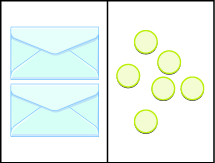
Figure 3.9.1
Here, there are two identical envelopes that contain the same number of counters. Remember, the left side of the workspace must equal the right side, but the counters on the left side are “hidden” in the envelopes. So how many counters are in each envelope?
To determine the number, separate the counters on the right side into 2 groups of the same size. So 6 counters divided into 2 groups means there must be 3 counters in each group (since 6÷2=3).
What equation models the situation shown in Figure 3.9.2? There are two envelopes, and each contains x counters. Together, the two envelopes must contain a total of 6 counters. So the equation that models the situation is 2x=6.
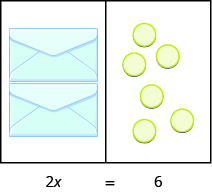
Figure 3.9.2
We can divide both sides of the equation by 2 as we did with the envelopes and counters.
2x2=62x=3
We found that each envelope contains 3 counters. Does this check? We know 2•3=6, so it works. Three counters in each of two envelopes does equal six. Figure 3.9.3 shows another example.
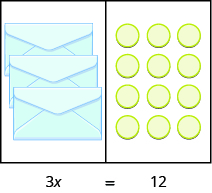
Figure 3.9.3
Now we have 3 identical envelopes and 12 counters. How many counters are in each envelope? We have to separate the 12 counters into 3 groups. Since 12÷3=4, there must be 4 counters in each envelope. See Figure 3.9.4.
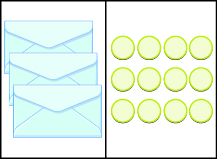
Figure 3.9.4
The equation that models the situation is 3x=12. We can divide both sides of the equation by 3.
3x3=123x=4
Does this check? It does because 3•4=12.
Write an equation modeled by the envelopes and counters, and then solve it.
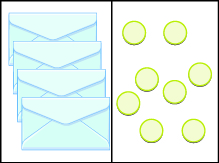
Solution
There are 4 envelopes, or 4 unknown values, on the left that match the 8 counters on the right. Let’s call the unknown quantity in the envelopes x.
| Write the equation. | 4x=8 |
| Divide both sides by 4. | 4x4=84 |
| Simplify. | x=2 |
There are 2 counters in each envelope.
Write the equation modeled by the envelopes and counters. Then solve it.
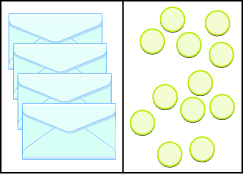
- Answer
-
4x=12; x=3
Write the equation modeled by the envelopes and counters. Then solve it.
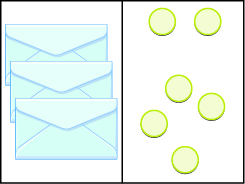
- Answer
-
3x=6; x=2
Solve Equations Using the Division Property of Equality
The previous examples lead to the Division Property of Equality. When you divide both sides of an equation by any nonzero number, you still have equality.
For any numbers a,b,c, and c≠0,
If a=b then ac=bc.
Solve: 7x=−49.
Solution
To isolate x, we need to undo multiplication.
| Divide each side by 7. | 7x7=−497 |
| Simplify | x=−7 |
Check the solution.
| Substitute −7 for x. | 7(−7)?=−49 |
| −49=−49✓ |
Therefore, −7 is the solution to the equation.
Solve: 8a=56
- Answer
-
7
Solve: 11n=121
- Answer
-
11
Solve: −3y=63.
Solution
To isolate y, we need to undo the multiplication.
| Divide each side by −3. | −3y−3=63−3 |
| Simplify. | y=−21 |
Check the solution.
| Substitute −21 for y. | −3(−21)?=63 |
| 63=63✓ |
Since this is a true statement, y=−21 is the solution to the equation.
Solve: −8p=96
- Answer
-
−12
Solve: −12m=108
- Answer
-
−9
Contributors and Attributions
- Lynn Marecek (Santa Ana College) and MaryAnne Anthony-Smith (formerly of Santa Ana College). This content produced by OpenStax and is licensed under a Creative Commons Attribution License 4.0 license.


